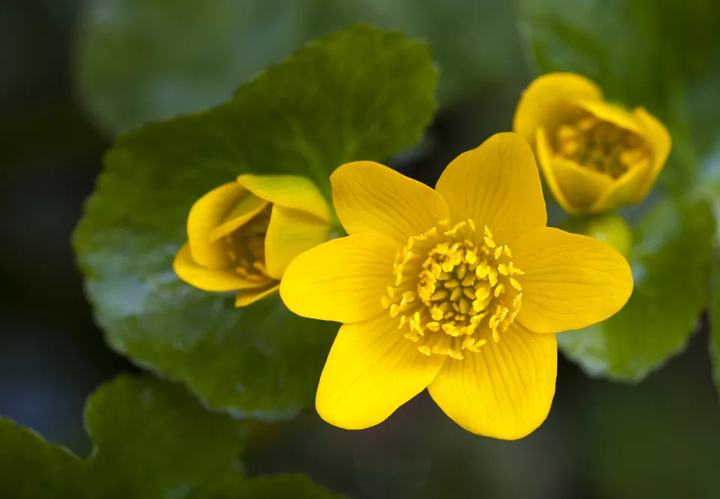Marsh Marigold (Caltha palustris) is also known as Caltha Cowslip. It is not really a marigold at all, rather a member of the Buttercup Family (Ranunculaceae).
The Marsh Marigold has no petals. Instead, each cluster of flowers is made of five to nine sepals, which resemble petals, surrounding many stamens and pistils.

Waxy deciduous foliage is rich green and each leaf is heart-shaped, kidney-shaped or rounded with two lobes.
Calling to the shape of these petite one-and-a-half-inch yellow blooms, caltha means “cup” coming from the Greek kalathos. Alluding to the ideal conditions for this flower to be planted, palustris means boggy or marshy. Other names are Marsh Cup or Cup of the Marsh.
Its growth habit is compact and mounding, the height ranging from one to three feet tall. For its dynamic purpose, this rhizomatous herbaceous perennial is known as both an herb and a wildflower.
Watch these vibrant perennials spread every spring, attracting the first birds, butterflies, and hummingbirds of the season.
Botanical Name:
Caltha palustris
Common Names:
Marsh Marigold, Cowslip, Kingcup, Cowflock; in Great Britain it is known as Mayflower, May Blobs, Mollyblobs, Pollyblobs, Horse Blob, Water Blobs, Water Bubbles, Gollins and the Publican
Plant Type:
Perennial herb and wildflower
Mature Size:
One to three feet tall, one to one-and-a-half feet wide
Sun Exposure:
Part sun to shade
Soil Type:
Humus rich loam (moist, boggy, muddy, wet-footed)
Soil pH:
Acidic (<6.8)
Bloom Time:
Spring
Flower Color:
Yellow
Hardiness Zones:
3-7, USA
Native Area:
Marshes, swamps, stream margins and wet meadows of Newfoundland and Alaska south to Nebraska, Tennessee and North Carolina
Marsh Marigold Care
Plant Marsh Marigold (Caltha palustris) in any moist or boggy area like the woodlands, a rain garden, or near a body of water.
They can also be planted alongside other bodies of water such as streams, and they are often the first pond plants to bloom in early spring. These low-maintenance buttercup blossoms come up from April to June.
Light
This perennial will bloom consistently in part sun to full shade – an unusual feature as most flowering plants for water gardens prefer full sun. Establish in a south-facing or west-facing direction for best results.
Find an especially shady afternoon spot in Zones 6 and 7, as being protected from extremely high temperatures will welcome the plant to bloom into summer and maintain healthy foliage.
Where summers are very hot, or in areas of direct sunlight, the Marsh Marigold may go dormant after blooming. Expect the foliage to wilt and die, and look forward to the following spring’s show.
Soil
Give this plant a rich, moist or boggy soil that is damp to fully submerged in water. If planting in a rain garden, situate it near the center of the lowest spot.
Water
Overall, plant in slow-draining areas. Adding a glorious yellow aesthetic to the edges of a pond or between the rocks near waterfalls, the Marsh Marigold is native to marshes, swamps, stream margins, and wet meadows in Newfoundland and Alaska south to Nebraska, Tennessee, and North Carolina. Still, they can survive drought by going dormant and returning the following year.
Is Marsh Marigold Toxic?
Traditional folk medicine and some Native American tribes use Caltha palustris as herbal medicine.
The tender leaves and buds of the marsh marigold are edible cooked, but, in their raw state, they contain a toxin called protoanemonin.
Symptoms of Poisoning
Plant juices may cause blistering or inflammation on the skin or mucous membranes. If juices are ingested, gastric illness may occur. Leaves are toxic in large quantities, potentially resulting in the throat burning, vomiting, bloody diarrhea, dizziness, fainting and convulsions.
Marsh Marigold Varieties
Caltha palustris 'Alba' is a white variety. The floating marsh marigold (C. natans) has white or pink sepals.
Propagating Marsh Marigold
These perennials can be propagated by root division and seed. Divide plants in early spring when foliage emerges. Replant immediately and water roots well.
How to Grow Marsh Marigold From Seed
Collect seeds off the plant towards the end of its bloom period and sow them when they ripen. Do not let them dry out. Start store-bought seeds in spring.
It may take about three years for seed-started marsh marigolds to mature and start blooming. It will be well worth the wait for these splendid wildflowers to cheerfully welcome many spring seasons to come.